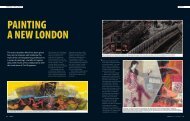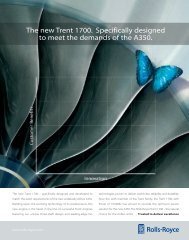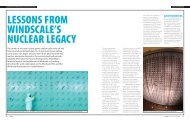[382-02] Heyman - Ingenia
[382-02] Heyman - Ingenia
[382-02] Heyman - Ingenia
Create successful ePaper yourself
Turn your PDF publications into a flip-book with our unique Google optimized e-Paper software.
JACQUES HEYMAN FREng<br />
EMERITUS PROFESSOR OF<br />
ENGINEERING, UNIVERSITY OF<br />
CAMBRIDGE<br />
INFRASTRUCTURE<br />
Why ancient<br />
cathedrals stand up<br />
The structural design of masonry<br />
How could the great<br />
architect–engineers of the past be<br />
sure that their buildings would<br />
stand up? What insights can we<br />
gain from their working practices?<br />
Professor Jacques <strong>Heyman</strong><br />
explores the techniques they used<br />
and relates them to present-day<br />
structural design.<br />
AGothic cathedral was designed<br />
by a man who was (to use<br />
modern terms) both architect<br />
and engineer. The ‘master of the work’<br />
had survived the long training of<br />
apprentice to journeyman to the career<br />
grade of master, and had been one of<br />
those outstanding masters who were<br />
put back to school again in the design<br />
office, before finally achieving control of<br />
a major work.<br />
This educational path contrasts<br />
strongly with that of present-day<br />
Western European practice, which is<br />
based on the Renaissance concept of<br />
the ‘gentleman’ architect. In England<br />
the precursor is Inigo Jones, but the<br />
first real architect is Wren, a professor<br />
of astronomy who had never worked on<br />
a building site. Despite his lack of<br />
practical training, Wren established the<br />
first modern architectural practice, with<br />
ingenia<br />
19
ingenia 20<br />
‘partners’ Robert Hooke and<br />
Woodroffe, and later Hawksmoor and<br />
others; he employed the first ‘quantity<br />
surveyor’, Scarborough; and he<br />
established the use of tendering by<br />
contractors, with payment based on<br />
agreed unit rates for measured work.<br />
Structural considerations<br />
Wren’s magnificent buildings<br />
occasionally encountered foundation<br />
difficulties, but they seemed to pose no<br />
structural problems (or at least there<br />
were none, with Hooke to help in the<br />
background). The structural<br />
considerations for the design of<br />
masonry are not those that would be<br />
recognised by the modern structural<br />
engineer. There are many minor criteria<br />
for design, but modern engineers are<br />
concerned primarily with problems of<br />
strength, stiffness and stability. The<br />
structure must be strong enough to<br />
carry whatever loads are imposed,<br />
including its own weight; it must not<br />
deflect unduly; and it must not develop<br />
INFRASTRUCTURE<br />
large unstable displacements, whether<br />
locally or overall.<br />
An immediate difficulty arises when<br />
these ideas are applied to masonry.<br />
Ancient structures – a Greek temple, the<br />
Roman Pantheon – seem intuitively to<br />
be strong enough; many are still<br />
standing, and evidently the loading (selfweight,<br />
wind, earthquake) has been<br />
resisted robustly. Similarly, the engineer<br />
is unlikely to worry unduly about large<br />
working deflexions of the vault of a<br />
Gothic cathedral. Further, instability is<br />
usually encountered as a local<br />
phenomenon; a slender steel column<br />
must be designed not to buckle,<br />
whereas the masonry pier in a nave<br />
arcade is ‘stocky’. In short, conventional<br />
ideas must be abandoned when<br />
approaching the analysis of masonry.<br />
The strength of stone<br />
The masonry structure is indeed<br />
‘strong’. Reference to nineteenthcentury<br />
practice is illuminating. An<br />
indirect parameter was used to express<br />
The central tower at Wells Cathedral was increased in height in 1315–20. The<br />
extra weight on the foundations caused uneven settlements of the four crossing<br />
piers and the cathedral mason, William Joy, took drastic action in 1338. His<br />
curved ‘strainer arches’ are sufficiently massive that they can contain straight<br />
thrust lines, and they form (in fact) scissor braces between the four piers.<br />
the strength of the stone chosen for the<br />
design of great masonry arches – the<br />
height to which, theoretically, a column<br />
of the stone might be built before<br />
crushing at its base due to its own<br />
weight. For a medium sandstone, the<br />
height is 2 km; for granite, 10 km. The<br />
tallest Gothic cathedral, Beauvais,<br />
measures 48 m to the top of the stone<br />
vault; of course, the piers carry more<br />
than their own weight, and must<br />
support the vault, the timber roof, and<br />
wind forces – nevertheless, stresses are<br />
very low. In round figures, the crossing<br />
piers carrying a tower in a cathedral will<br />
be working at an average stress of less<br />
than one tenth of the crushing strength<br />
of the stone; main structural elements –<br />
flying buttresses, webs of masonry<br />
vaults – at one hundredth; and infill<br />
panels and the like at one thousandth<br />
of the potential of the material.<br />
A vast masonry building is made by<br />
piling small stone blocks one on<br />
another – the resulting shape is given a<br />
label such as Byzantine, Romanesque<br />
or Gothic. If the assumption is made<br />
that this stone pile is capable of<br />
absorbing very large compressive<br />
forces, but, on the contrary, can resist<br />
only feeble tensions (weak mortar will<br />
offer little resistance to the work being<br />
pulled apart), then an account of<br />
masonry action can be given within the<br />
framework of modern plastic theory.<br />
This theory was devised initially for the<br />
design of ductile steel structures, but<br />
the powerful new theorems can be<br />
‘translated’ to account for the<br />
behaviour of masonry.<br />
Geometries of equilibrium<br />
It turns out that ‘stress’ requirements,<br />
such as are needed for the design of<br />
steel or reinforced concrete, are<br />
transformed into ‘geometrical’<br />
requirements for the design of masonry.<br />
The shape of a masonry element – a<br />
flying buttress, for example – must obey<br />
simple rules. In essence, the internal<br />
forces in the element, which are subject<br />
to the laws of static equilibrium, must lie<br />
within the boundaries of the masonry.
Building a masonry arch<br />
A simple masonry arch (for example,<br />
for a bridge over a river) is made<br />
from identical wedge-shaped pieces<br />
known as voussoirs. The arch is built<br />
on falsework (a temporary<br />
supporting framework) since it<br />
cannot stand until the last stone, the<br />
keystone, is in place. Once<br />
complete, the falsework is removed<br />
and the arch at once starts to thrust<br />
at the river banks. Inevitably the<br />
abutments will give way slightly and<br />
the arch will spread.<br />
The lower figure, greatly<br />
exaggerated, shows how the arch<br />
accommodates itself to the<br />
increased span. The arch has<br />
cracked between voussoirs – there is<br />
no strength in these joints, and three<br />
hinges have formed. The arch is not,<br />
however, on the point of collapse –<br />
the three-hinge arch is a well-known<br />
and perfectly stable structure. The<br />
arch has merely responded in a<br />
sensible way to an attack from a<br />
hostile environment.<br />
Example: the masonry arch<br />
A simple example makes clear the<br />
requirement. A ‘classical’<br />
seventeenth/eighteenth century problem<br />
was the analysis of the masonry arch –<br />
how does the arch carry its loads?<br />
Hooke gave the answer to this problem<br />
in 1675: As hangs the flexible chain, so<br />
– but inverted – will stand the rigid arch.<br />
Thus the ‘catenary’, inverted, will give<br />
INFRASTRUCTURE<br />
the line of the resultant forces within the<br />
masonry, and this inverted chain must<br />
lie within the extrados (upper surface)<br />
and intrados (lower surface) of the arch.<br />
If, for example, the arch were<br />
semicircular (and thus not geometrically<br />
similar to the inverted chain), then it<br />
would be stable only if it had a certain<br />
minimum thickness (about 10% of the<br />
radius for a full semicircle).<br />
The ‘safe theorem’<br />
Hooke’s insight is confirmed by the ‘safe<br />
theorem’ of the plastic theory of design.<br />
The laws of static equilibrium are<br />
paramount; the theorem states that if a<br />
set of internal forces in a masonry<br />
structure can be found that equilibrate<br />
the external loads, and which lie<br />
everywhere within the masonry, then the<br />
structure is safe – safe in the sense that<br />
it cannot collapse under those loads.<br />
The importance of this theorem for the<br />
analyst is that it is not necessary to<br />
determine the ‘actual’ state of the<br />
structure; any one satisfactory<br />
equilibrium solution demonstrates<br />
stability. Indeed, there is no actual state<br />
for any structure, whether built of<br />
masonry, steel, or any other material.<br />
There is, of course, an ideal state<br />
imagined by the designer (or by the<br />
computer making the design), and<br />
there is in practice a state here-andnow,<br />
but any small disturbance – a<br />
small foundation settlement, a lurch in<br />
the wind, an earth tremor, a decay of<br />
mortar, a slip in a connexion – will<br />
cause a huge alteration to the values of<br />
internal stresses. The only real basis for<br />
design is to clothe a reasonable<br />
equilibrium pattern of forces with<br />
suitable constructional material.<br />
Correct shapes and<br />
proportions<br />
Thus the design of masonry is<br />
transformed into the creation of the<br />
correct shapes for individual elements,<br />
and for assemblies of such elements<br />
into larger units – arcades, cross-vaults,<br />
domes. These correct geometrical<br />
shapes were established by trial and<br />
error, and crystallised into rules;<br />
geometry can of course be expressed<br />
by numbers – the height of a column<br />
must not exceed a certain multiple of its<br />
diameter, for example, or again (for<br />
Greek temples) that the distance<br />
between columns must also depend on<br />
their diameter. Numerical rules form the<br />
substance of a few chapters in the<br />
book of Ezekiel, which preserves part of<br />
a builder’s manual of 600 BC; the rules<br />
are repeated in Vitruvius, about 30 BC;<br />
and they are the basis of a good part of<br />
the secrets of the medieval masonic<br />
lodges. Structural engineering was<br />
design by numbers.<br />
The fifteenth century saw the end of<br />
this unbroken tradition of 2000 years.<br />
Alberti’s On the art of building of 1452<br />
marks the break – he stressed, above<br />
Stability of an arch<br />
The semicircular arch in Figure (a)<br />
below is thick enough to contain<br />
easily the line of thrust (the inverted<br />
hanging chain, shown as a dashed<br />
line) between its upper surface, the<br />
extrados, and the lower, the<br />
intrados. The arch of Figure (b),<br />
however, is only just thick enough,<br />
and it is on the point of collapse by<br />
the formation of hinges, as shown in<br />
Figure (c).<br />
ingenia<br />
21
ingenia 22<br />
The Gothic cathedral: Westminster Abbey<br />
The diagram shows the cross-section of a typical Gothic<br />
cathedral. A stone vault covers the high central space, the<br />
nave; the nave is flanked by lower side aisles, themselves<br />
vaulted in stone. A tall timber roof covers the nave vault –<br />
a stone vault would let in water and need<br />
weatherproofing. However, the timber roof is a fire hazard<br />
and the stone provides some protection.<br />
The stone vault thrusts horizontally and if there were no<br />
side aisles, the massive external butresses could be<br />
placed directly against the north and south walls of the<br />
church to discharge the thrusts to the ground. As it is, the<br />
vault thrust is taken over the tops of the side aisles by<br />
means of flying butresses. On the north side of<br />
Westminster Abbey the lower of the two flying butresses<br />
props the vault; the upper buttress collects any wind force<br />
that may act on the timber roof, and also helps to control<br />
the tendency of a timber roof to spread.<br />
On the south side of the Abbey, a cloister abuts the<br />
wall of the aisle and the main buttressing pier must be<br />
placed yet further away. A relatively slender intermediate<br />
pier is introduced, and the two upper flying buttresses<br />
form two-span inclined arches. The aisle vault also needs<br />
propping; this is accomplished by the main buttressing<br />
pier on the north side and by a third level of flying<br />
buttresses over the cloister on the south.<br />
INFRASTRUCTURE<br />
The cross-section of St Paul’s Cathedral<br />
St Paul’s Cathedral was built over the period 1675–1711<br />
and cost the immense sum of £747,660.<br />
The triple dome of St Paul’s Cathedral (spanning 34 m)<br />
consists of a lead-covered timber outer structure, the true<br />
conical brick and stone dome supporting the massive<br />
lantern, and the inner dome (like the Pantheon, with an<br />
‘eye’) which is all that is seen from the inside of the<br />
building.<br />
The essential difference between Wren’s dome for St<br />
Paul’s and all previous domes lies in the inclined surfaces<br />
of the supporting structure – the masonry never becomes<br />
vertical, but follows the line of Hooke’s (three-dimensional)<br />
hanging chain. This inclination is disguised externally by<br />
the vertical colonnades of the drum and is not detectable<br />
internally when standing on the floor of the church; it can<br />
however be seen from the Whispering Gallery.
all, the importance of proportion for<br />
correct and beautiful building.<br />
Brunelleschi had made exact<br />
measurements of classical buildings in<br />
Rome; with the invention of printing, an<br />
illustrated Vitruvius could be published,<br />
and the Renaissance of Roman<br />
Architecture was underway.<br />
Two hundred years later, this heritage<br />
was available to Wren. He had no need<br />
to learn proper shapes by cutting stone<br />
in the yard; correct proportions which,<br />
by experience, guaranteed stability,<br />
were to be seen abroad (one year in<br />
Paris) and in books. Only the dome was<br />
difficult – Wren had solved some<br />
geometrical problems with the lath and<br />
plaster dome of St Stephen Walbrook,<br />
but there was real structural engineering<br />
involved with the much larger dome of<br />
St Paul’s. The shape of Hooke’s<br />
catenary gives the reasonable shape for<br />
the two-dimensional arch; Hooke<br />
himself extended his idea to the threedimensional<br />
dome, and St Paul’s is built<br />
accordingly.<br />
In conclusion<br />
INFRASTRUCTURE<br />
The Romanesque cathedral at Ely was built between 1081 and 1140; at the end of<br />
this period there was a central tower over the crossing, and the great west tower<br />
lacked its top storey. In 1240 the choir was extended by six bays in Gothic style,<br />
in order to accommodate the great press of pilgrims. In 1321 work began on the<br />
Lady Chapel and, perhaps as a consequence of interference with the water table,<br />
the central tower fell a year later. The central space was then opened out to an<br />
octagon measuring 24 m, and the unique timber lantern, a feat of structural<br />
engineering, was built in 1340. The top storey of the west tower, also of octagonal<br />
form, was added in 1380.<br />
design, made by laborious hand author of twelve books and co-<br />
The safe theorem is the rock on which<br />
calculation or by a computer, refers to author of two others, and has also<br />
the whole science of structural<br />
an ideal structure, and the stresses written numerous articles on the<br />
engineering is constructed. The<br />
confidently predicted by the designer plastic design of steel structures,<br />
theorem can be put simply – if the<br />
cannot be observed in practice. Never- masonry construction, general<br />
designer can find a way in which a<br />
theless the elastic solution is one, out of structural theory and the history of<br />
structure is comfortable under the<br />
an infinity of equilibrium solutions, with structural<br />
action of certain specified loads, then<br />
which the structure is comfortable. ■ analysis. He<br />
the structure is safe. The designer need<br />
acts as<br />
find only one such way – this will not be<br />
consultant<br />
the way in which the structure chooses Further reading<br />
engineer for<br />
to be comfortable, but if the designer<br />
Some of the illustrations are taken from a number of<br />
can find a way, then so can the<br />
Chapter 3 of J. <strong>Heyman</strong>, The science English<br />
structure. Moreover, that way will<br />
of structural engineering, Imperial cathedrals,<br />
change continuously through the life of<br />
College Press, 1999.<br />
and has<br />
the building, but repeated attacks by a<br />
written many<br />
hostile environment will always generate For a deeper analysis of masonry, see<br />
structural<br />
new states of safe equilibrium (unless, J. <strong>Heyman</strong>, The stone skeleton,<br />
reports on<br />
indeed, the attacks amount to wilful Cambridge University Press, 1995<br />
these and on other great churches.<br />
destruction – violent earthquakes or (paperback 1997, 1999).<br />
He has served for many years as a<br />
acts of war).<br />
member of the Cathedrals Fabric<br />
Applied to modern building, in steel<br />
Jacques <strong>Heyman</strong> retired in 1992 as Commission for England, and of the<br />
or reinforced concrete, for example, the<br />
Professor and Head of the<br />
Architectural Advisory Panel for<br />
theorem explains why conventional<br />
Department of Engineering at the Westminster Abbey.<br />
elastic design is a safe process. Such a ingenia<br />
University of Cambridge. He is the Email: jh100<strong>02</strong>@eng.cam.ac.uk<br />
23


![[382-02] Heyman - Ingenia](https://img.yumpu.com/11626821/1/500x640/382-02-heyman-ingenia.jpg)






![[322/03] Francke - Ingenia](https://img.yumpu.com/23411337/1/184x260/322-03-francke-ingenia.jpg?quality=85)







